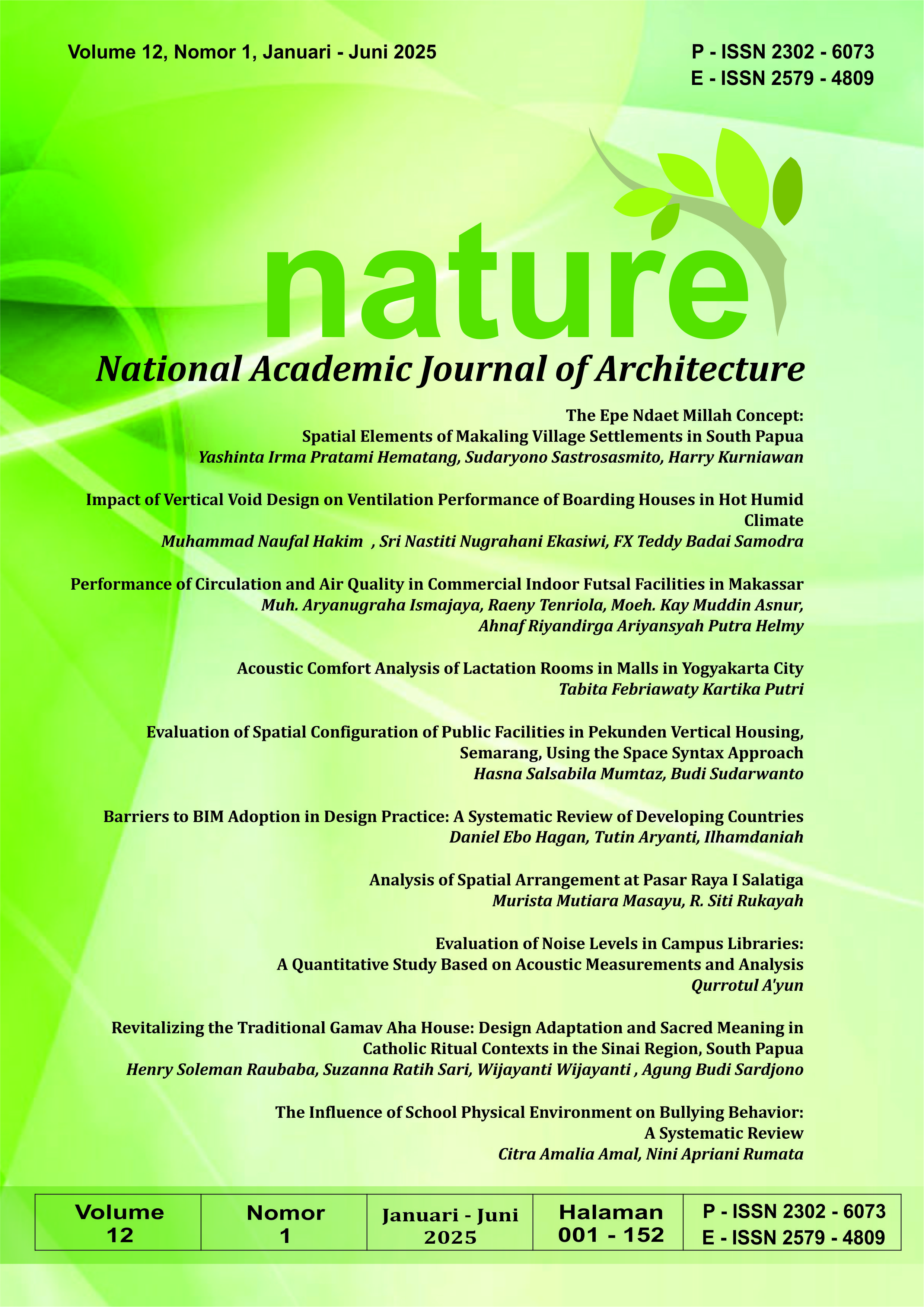Efek Ventilasi Void terhadap Pendinginan Fisiologis dan Konsentrasi CO2 pada Bangunan Kos di Iklim Tropis Lembab
DOI:
https://doi.org/10.24252/nature.v12i1a2Kata Kunci:
Void Vertikal, Penghawaan, Pendinginan, Kualitas UdaraAbstrak
Void vertikal dapat meningkatkan kinerja penghawaan alami untuk pendinginan fisiologis dan kualitas udara dalam ruangan (IAQ), khususnya pada rumah kos sebagai bentuk hunian bersama. Pengaruh void terhadap penghawaan ditentukan oleh berbagai variabel desain seperti proporsi bukaan, rasio void terhadap bangunan, aspek rasio void, dan posisi void. Melalui modifikasi variabel-variabel desain tersebut, efek void vertikal terhadap penghawaan dapat ditingkatkan. Untuk menyelidiki pengaruh variabel desain terhadap kinerja penghawaan, penelitian dilakukan melalui survei lapangan dan pengukuran kondisi iklim mikro. Metode statistik deskriptif digunakan untuk menganalisis pengaruh desain yang berbeda pada dua rumah kos terhadap kinerja penghawaan. Hasil penelitian ini dapat digunakan sebagai pertimbangan desain hunian bertingkat rendah untuk meningkatkan kinerja penghawaan alami. Temuan menunjukkan bahwa kualitas udara yang ditentukan oleh konsentrasi CO2 tetap berada di sekitar 400–600 ppm. Hal ini disebabkan oleh tingkat habitasi yang rendah dan volume void yang besar, terlepas dari desain void atau kecepatan udara. Kecepatan aliran udara sebagai indikator pendinginan fisiologis bervariasi antara siang dan malam. Penghawaan pada siang hari lebih efektif untuk lantai atas karena daya apung termal dan kecepatan angin yang lebih tinggi. Penghawaan malam hari kurang memadai dengan aliran udara yang lebih lemah, terutama untuk pendinginan fisiologis di lantai atas. Penyesuaian rasio void dapat meningkatkan kinerja penghawaan alami. Void yang sempit meningkatkan aliran udara ke atas pada malam hari, sedangkan rasio aspek void yang lebih besar meningkatkan aliran udara pada siang hari.
Unduhan
Referensi
Alfata, M. N. F., Hirata, N., Kubota, T., Nugroho, A. M., Uno, T., Ekasiwi, S. N. N., & Antaryama, I. G. N. "Field Investigation of Indoor Thermal Environments in Apartments of Surabaya, Indonesia: Potential Passive Cooling Strategies For Middle-Class Apartments." Energy Procedia 78 (2015); 2947–2952.
Allard, F., & Ghiaus, C. (2005). Natural Ventilation in the Urban Environment: Assessment and Design. Earthscan.
ASHRAE. (2017). Ansi/Ashrae Standard 55-2017 Thermal Environmental Conditions for Human Occupancy. ASHRAE.
Chauytong, T., Jareemit, D., & Liu, J. (2022). Impact of Sky Terrace Locations on Pedestrian Ventilation and Air Quality in High-Density Areas Using CFD Simulation. International Conference and Utility Exhibition on Energy, Environment and Climate Change (ICUE), pp. 1–10.
Cheng, Y., Fong, M. L., Yao, T., Lin, Z., & Fong, K. F. “Uniformity Of Stratum-Ventilated Thermal Environment and Thermal Sensation.” Indoor Air 24 (2014); 521–532.
Dezfuli, R. R., Bazazzadeh, H., Taban, M., & Mahdavinejad, M. "Optimizing Stack Ventilation in Low And Medium-Rise Residential Buildings in Hot and Semi-Humid Climate." Case Studies in Thermal Engineering 52, March (2023); 103555.
Diaz, E., Patino, L., & Siegel, A. “Indoor Environmental Quality in Social Housing: a Literature Review.” Building and Environment 131 (2018); 231–241.
Du, B., Tandoc, M., Mack, M. L., & Siegel, J. A. "Indoor CO2 Concentrations and Cognitive Function: A Critical Review" Indoor Air 30, no.6 (2020); 1067–1082.
Farea, T. G., Ossen, D. R., Alkaff, S., & Kotani, H. "CFD Modeling for Natural Ventilation in a Light Well Connected To Outdoor Through Horizontal Voids." Energy & Buildings 86 (2015); 502–513.
Fisk, W., Wargocki, P., & Zhang, X. "Do Indoor CO2 Levels Directly Affect Perceived Air Quality, Health, or Work Performance?" ASHRAE Journal 61, no. 9 (2019); 70–77.
Ghaffarianhoseini, A., Berardi, U., & Ghaffarianhoseini, A. "Thermal Performance Characteristics of Unshaded Courtyards in Hot and Humid Climates." Building and Environment 87 (2015); 154–168.
Hakim, M. N., Ekasiwi, S. N. N., & Samodra, F. X. T. B. “Design parameters for enhancing passive ventilation using vertical void in hot humid climate with high density.” IOP Conference Series: Earth and Environmental Science 1439, no. 1 (2025); 12028
Indah, I., & Wardono, P. "Co-living space: The Shared Living Behavior of the Millenial Generation in Indonesia." ARTEKS : Jurnal Teknik Arsitektur 6, no.2 (2021); 199–214.
Jia, L.-R., Han, J., Chen, X., Li, Q.-Y., Lee, C.-C., & Fung, Y.-H. "Interaction between Thermal Comfort, Indoor Air Quality and Comprehensive Review." Buildings 11 (2021); 591.
Kotani, H., Satoh, R., & Yamanaka, T. "Natural ventilation of light well in high-rise apartment building." Energy and Buildings 35 (2023); 427–434.
Kubota, T., Zakaria, M. A., Abe, S., & Toe, D. H. C. "Thermal Functions of Internal Courtyards in Traditional Chinese Shop Houses in the hot-humid climate of Malaysia." Building and Environment 112 (2017); 115–131.
Kumar, Nikhil, Bardhan, R., Kubota, T., Tominaga, Y., & Shirzadi, M. "Parametric study on vertical void configurations for improving ventilation performance in the mid-rise apartment building." Building and Environment 215, February (2022); 108969.
Kumar, Nikhil, Bardhan, R., Kubota, T., Tominaga, Y., & Shirzadi, M. "Experimental study on vertical void for improving natural ventilation in midrise double-loaded apartments." E3S Web of Conferences 398 (2023a); 1977–1986.
Kumar, Nikhil, Bardhan, R., Kubota, T., Tominaga, Y., & Shirzadi, M. "Parametric Study on Vertical Void Configurations for Improving Natural Ventilation in Double-Loaded Apartments." Environmental Science and Engineering (2023b); 1977–1986.
Kumar, Nikhil, Kubota, T., Tominaga, Y., Shirzadi, M., & Bardhan, R. "CFD Simulations of Wind-Induced Ventilation in Apartment Buildings with Vertical Voids: Effects of Pilots and Wind Fin on Ventilation Performance." Building and Environment 194, (2021); 107666.
Latif, S., Idrus, I., & Ahmad, A. "Kenyamanan Termal pada Rumah Kos (Studi Kasus Pondok Istiqomah di Makassar)." Jurnal Linears 2, no. 1 (2019); 1–7.
Lestinen, S., Kilpeläinen, S., Kosonen, R., & Jokisalo, J. “The flow interaction of air distribution with thermal plumes and the effect on the air velocity fluctuation under increased heat load conditions.” (2017).
Liu, J., Dalgo, D. A., Zhu, S., Li, H., Zhang, L., & Srebric, J. “Performance analysis of a ductless personalized ventilation combined with radiant floor cooling system and displacement ventilation.” Building Simulation 12 (2019); 905–919.
Mareed, W. M., & Hussen, H. M. “Numerical and Experimental Modeling of Indoor Air Quality Inside a Conditioned Space with Mechanical Ventilation and DX-Air Conditioner.” Engineering and Technology Journal 38, no. 9 (2020); 1257–1275.
Muhaisen, A. S. "Shading simulation of the courtyard form in different climatic regions." Building and Environment 41 (2006); 1731–1741.
Muhsin, F, Yusoff, W. F. M., Mohamed, M. F., Rasidi, M., Rasani, M., & Sapian, A. R. "Potential of voids to enhance natural ventilation in medium cost multi-storey housing (MCMSH) for hot and humid climate." ARPN Journal of Engineering and Applied Sciences 12, no.10 (2017).
Muhsin, F, Yusoff, W. F. M., Mohamed, M. F., & Sapian, A. R. "The effects of void on natural ventilation performance in multi-storey housing." Buildings 6, no. 35 (2016).
Muhsin, Fakhriah, Yusoff, W. F. M., Mohamed, M. F., & Sapian, A. R. "CFD modeling of Natural Ventilation In a Void Connected to the Living Units of Multi-Storey Housing for Thermal Comfort." Energy and Buildings, 144 (2017); 1–16.
Murakami, S., Kato, S., Ooka, R., & Shiraishi, Y. "Design of a Porous-Type Residential Building Model With Low Environmental Load in Hot and Humid Asia." Energy and Buildings 36, no.12 (2004); 1181–1189.
Nagasue, M., Kitagawa, H., Asawa, T., & Kubota, T. "A Systematic Review of Passive Cooling Methods in Hot and Humid Climates Using a Text Mining-Based Bibliometric Approach." Sustainability 16, no.4 (2024); 1420.
Nejat, P., Ferwati, M. S., Calautit, J., & Ghahramani, A. "Passive Cooling and Natural Ventilation by the Windcatcher (Badgir): an Experimental and Simulation Study of Indoor Air Quality, Thermal Comfort and Passive Cooling Power." Journal of Building Engineering 41, March (2021); 102436.
Nicol, F., & Roaf, S. (2008). Progress on Passive Cooling: Adaptive Thermal Comfort and Passive Architecture. In M. Santamouris (Ed.), Advances in Passive Cooling (1st ed., pp. 1–29). Routledge.
Nugroho, A. M. "The Impact of Tropical Vernacular Courtyard on Air Temperature Reduction The Case Study of Djaduk Ferianto’s House." Local Wisdom: Jurnal Ilmiah Kajian Kearifan Lokal 15, no.2 (2023); 81–94.
Nugroho, A. M., Citraningrum, A., Iyati, W., & Hamdan, M. "Courtyard as Tropical Hot Humid Passive Design Strategy: Case Study of Indonesian Contemporary Boarding Houses in Surabaya Indonesia." Journal of Design and Built Environment 20, no.2 (2020); 1–12.
Olgyay, V., Lyndon, D., Reynolds, J., & Yeang, K. (2015). Design with Climate: Bioclimatic Approach to Architectural Regionalism - New and expanded Edition. Princeton University Press.
Oktavallyan, S. D., Seftyarizki, D., & Wardhani, F. “Student Boarding House Quality in term of Health Design (Case study: Boarding House near University of Bengkulu).” IOP Conference Series: Earth and Environmental Science 738, no. 1 (2021).
Parsons, K. (2002). Human Thermal Environments The Effects of Hot, Moderate, and Cold Environments on Human Health, Comfort, and Performance (Third Edit). CRC Press, Taylor & Francis Group, LLC.
Rajapaksha, I., Nagai, H., & Okumiya, M. "A ventilated courtyard as a passive cooling strategy in the warm humid tropics." Renewable Energy 28, no. 11 (2003): 1755–1778.
Ristanto, D. F., Gabe, R. T., & Adianto, J. "User behaviour and circulation in an indonesian student communal housing facility: Combining space syntax and actor network theory." A/Z ITU Journal of the Faculty of Architecture 18, no. 3 (2021); 611–623.
Samodra, F. X. T. B. "Analysis of Resilient Design by Thermoacoustic Adaptation of Tropical Urban Model." Journal of Architecture and Urbanism 41, no. 4 (2017); 305–315.
Samudro, H., Samudro, G., & Mangkoediharjo, S. (2023). Bangunan Sehat: Perancangan Volume Ruang dan Remediasi Lingkungan. PT Nas Media Pustaka.
Szokolay, S. V. (2008). Introduction to Architectural Science: The Basis of Sustainable Design (2nd ed.). Elsevier.
Unduhan
Diterbitkan
Cara Mengutip
Terbitan
Bagian
Lisensi
Hak Cipta (c) 2025 Muhammad Naufal Hakim, Sri Nastiti Nugrahani Ekasiwi, FX Teddy Badai Samodra

Artikel ini berlisensiCreative Commons Attribution-ShareAlike 4.0 International License.
By submitting your manuscript to our journal, you are following Copyright and License






















